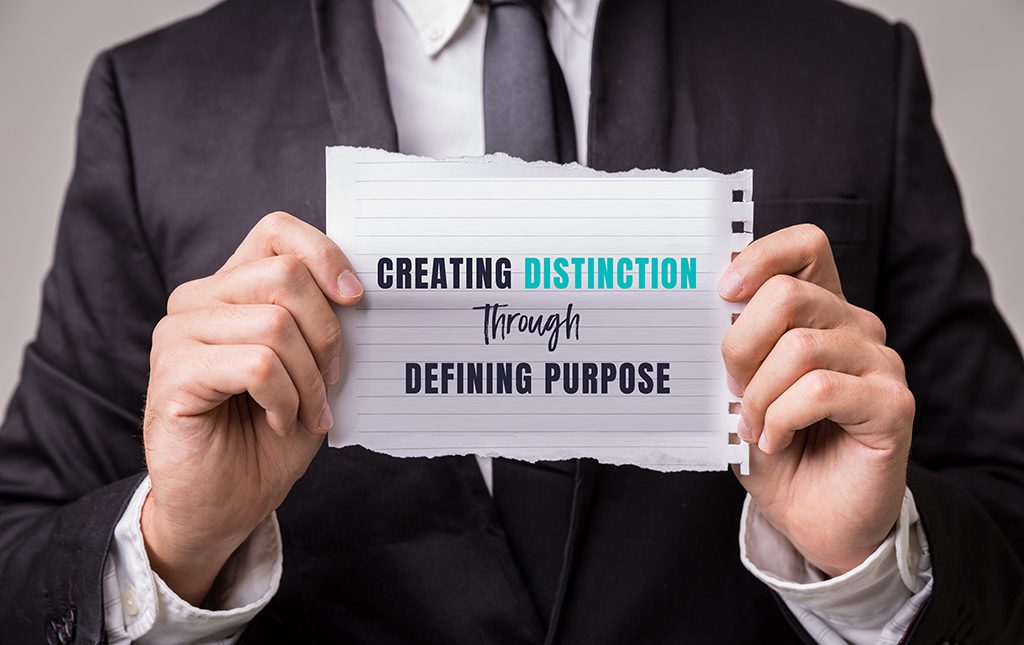
Mar 19, 2022 | Business Distinction, ICONIC, Leadership, Personal Distinction
There are so many variables competing for our attention today it’s easy to get bogged down in the minor details and lose focus on what’s important. When trying to achieve a critical task, it’s crucial to stay focused and not let distractions get in the way.
It’s all too easy to let the minor things take priority over the significant goals. But if you want to succeed, you need to learn to control your focus and stay on track. Don’t let the minor things overshadow the major ones – focus on what’s important and achieve your goals! Only by keeping your eye on the prize can you achieve great things.
The late, great business philosopher, Jim Rohn, used to ask, “Are you majoring in minor things?” It’s a brilliant question. Frequently, we can get so caught up in the details that we overlook the primary purpose. We focus on the small aspects rather than what’s most important.
Remember, the first Cornerstone of Distinction is CLARITY! It’s essential to keep your priorities straight so you can create distinction. Knowing what is truly important makes it easier to stay focused and motivated.
- Stay in control of your focus, and don’t let distractions get in the way of your success.
“The more you know, the more you realize how much you don’t know.” – Aristotle.
Knowledge is the first step to power. The most innovative people are constantly learning and expanding their horizons. The more you learn, the better equipped you’ll be to focus on what’s important and achieve your goals. Don’t be afraid to ask for help – there’s no shame in admitting you don’t know everything.
The second step, however, is action. We often joke about being online and going “down the rabbit hole” — in other words, we get so distracted and engaged with the next link online or the next video on YouTube that we spend hours on the trivial than the vital. If knowledge were all that was necessary to achieve success, the center of the universe would be on college campuses.
Here are three steps to maintaining focus:
1. Know your priorities.
It’s only recently that the word “priority” also had a plural version. The word priority was created to signify the one aspect that was THE most important of all items we are considering. It’s essential to limit the number of items you’ll focus on — and know them thoroughly.
2. Stay disciplined
The importance of discipline is frequently underrated. It’s the ability to do what you should do when you should do it, whether you feel like it or not. It’s the key to achieving success and staying on track. Discipline allows you to focus on your goals and ignore distractions.
3. Take action!
With so many distractions today, it can be easy to lose focus on what’s important. If something is essential, you’ll find a way to get it done. But if you want to achieve great things, you need to stay focused and go to work! It’s up to you to take control of your focus and stay on track.
“What gets scheduled, gets done.” – Brian Tracy.
So, are you majoring in minor things? If you want to be successful, you must clarify what’s important and stay on track. Only by keeping your eye on the prize can you achieve great things.
- Don’t permit the minor aspects to overshadow the major ones – have clarity on what is important and achieve your distinctive goals!

Mar 5, 2022 | Business Distinction, Customer Experience, ICONIC, Sales & Retail
At a recent event held at a Four Seasons hotel, an audience member for my keynote presentation came up following my program. “Hi,” he said, “I’m Jerry – and, boy, do I have a story for you!”
“Yesterday, my wife and I were dining at the breakfast buffet here at the Four Seasons,” Jerry told me. “As we proceeded down the line, I just happened to mention to my wife that I wished they had blueberries available. Don’t get me wrong — they had a beautiful array of fruit. It’s just that there weren’t any blueberries, which are my favorite!”
“Imagine my surprise,” Jerry continued, “when mere moments later, a Four Seasons team member came to our table with a bowl of the most beautiful blueberries you could imagine! A young lady happened to overhear my conversation with my wife. She told me, ‘We don’t want you to be disappointed with ANY part of your experience at Four Seasons!'”
As Jerry and I continued the conversation, he was supremely impressed with two aspects of this encounter:
- She listened to the customer.
- She took action to ensure the customer received exactly what he wanted.
Let’s examine both steps:
First, listening to the customer. This Four Seasons team member was tuned in to what Jerry wanted and needed. She didn’t just hear the words. She listened to the emotion behind them. Because she listened, she knew that blueberries were important to him and acted on it.
Listening is critical because it communicates to the customer that they are essential and that their wants and needs are a priority. How many times have you been in a customer service situation where you feel like you’re not being heard? We, as customers, feel like our voices are falling on deaf ears all too often. Too often, we as customer service professionals, stop at listening. We need to go the extra mile and take action to ensure that our customers receive what they want.
When we take the time to listen to our customers, it shows that we care about them and their experience.
Second, taking action to ensure the customer received exactly what he wanted. This Four Seasons team member not only listened but also took action to ensure Jerry’s happiness. She knew that blueberries were important to him, so she brought him a bowl of them.
Consider what the alternatives were for the employee —
- She could have been daydreaming or thinking about something else about her job and not tuned in to the customer.
- She could have thought, “We have LOTS of great fruit…and it’s not enough for this guy?”
- She could have told her manager, “By the way, a customer noted there weren’t blueberries. Maybe we should put some out tomorrow.”
Instead, she took ownership of the customer’s modest identification of a missing element.
Educating your team to own the problem and create the solution is critical.
Taking ownership of customer issues and being proactive in solving them is another hallmark of delivering a difference. Often, the small things that we do for our customers make the most significant impact.
Jerry’s story is an excellent reminder of how important it is to listen to our customers and take action on their behalf. When we do this, we deliver an Ultimate Customer Experience. What Jerry experienced was a great example of a UCE. His Four Seasons team member went the extra mile to ensure that he received exactly what he wanted.
Here’s an additional aspect — most of us know that this isn’t a unique experience for Four Seasons customers — it’s part of their DNA.
As my pal, Joe Calloway often discusses, most companies share an experience wildly out of the norm. They want you to know about the employee who walked a mile through the snow to be certain that a customer got their pack of chewing gum.
The problem is that the same store doesn’t do the basic blocking and tackling, which ensures that the little things are done right for every customer, every time.
Remember, customers do not want us to make it right. They want us to GET it right!
Because of the actions of this employee, Jerry left feeling appreciated and delighted with his experience at the Four Seasons. In fact, he was so impressed, he felt compelled to share his story with me — and now, I’m sharing it with you!
This is vitally important! When customers share your success stories, they become your advocates in a crowded marketplace. (And what business doesn’t want more advocates?)
When your team (and you) can deliver this level of customer experience, you’re well on your way to becoming ICONIC!

Feb 5, 2022 | ALL Business is STILL Show Business, Business Distinction, ICONIC, Leadership, Sales & Retail
Here’s a problematic question for entrepreneurs and managers: is it that people don’t want to work nowadays? Or is it that they don’t want to work for YOU?
Twenty years ago, I wrote that you must provide the “Ultimate Experience” for both customers and employees. Over the past two decades, we’ve observed significant strides in how organizations engage their customers. Frankly, we haven’t seen that level of progress across the board regarding employee engagement.
In the United States, we’ve heard many leaders talk about how today’s employees don’t want to work and are lazy. Many studies are confirming this is not true. The companies and managers who have had problems with employee engagement have failed to create an environment where their staff was happy or felt it was a place they wanted to work.
To have a successful business, you need happy and engaged employees. It’s not only the right thing to do, but it’s also good for business. Employees who are disengaged cost businesses billions of dollars every year in lost productivity. Gallup has even gone as far as saying that employee engagement is the key to success for any organization.
Here are a couple of questions for you:
- Have you designed the employee experience with as much passion and precision as you plan customer acquisition?
- Have you developed a specific list of WHY both current and prospective employees would recognize working for you as a superior option from their other opportunities?
For most, frankly, the answer will be, “No.”
That needs to change — and it needs to change now if you want to attract and retain a superior team.
So, what can you do to create an environment where your employees want to work? It’s not easy and takes time, but here are five tips:
- Treat your employees with respect. This includes listening to them and considering their ideas.
- As I wrote in “ICONIC,” respect is reciprocal. If you want your team to respect and value you and your organization, you must display how you value and respect them FIRST.
- Make certain they feel appreciated. The best way to make your employees feel part of the company is by giving them ongoing recognition. In other words, leaders don’t recognize their work only when milestones are met or when achieving sales targets.
- Recognition can be in many forms, including praise for doing a job well done, even if it’s not on the radar screen yet.
- Offer them development opportunities. No one wants to feel like they’re stuck in a dead-end job.
- Employees want to know that there is room for growth and that they are valued enough for the company to invest in their future.
- Let them have some fun! Work can be stressful, so it’s essential to find ways for employees to let off some steam.
- Whether through social activities, team-building exercises, or just taking a break for a little bit, employees need to know that they can have fun at work and not be all work and no play.
- Finally, PAY MORE! My great pal, Randy Pennington, related a story on a recent live stream where we both were guests about a consulting client of his that dramatically increased the compensation of his team. Guess what? It SAVED him money!
- How could this be the case?
- He reduced his expenses of recruiting and onboarding new team members.
- He drastically reduced turnover.
- He kept his best employees and attracted top-level recruits.
- He prevented massive overtime outlays because he now had a productive team that could get the work done during regular hours.
- AND the fact that no one had to put in extra time meant happier employees and families.
The next time you think about how employees “just don’t want to work today,” remember it’s not because they’re lazy. It’s likely because they aren’t attracted to work for a company that they aren’t certain appreciates them or doesn’t have their best interests at heart.
Change your ways and see how your employees change their tune!
If you can successfully implement these tips, you’ll be well on your way to having an engaged and happy team!

Dec 13, 2021 | Business Distinction, ICONIC, Leadership, News & Info
Few management blunders have attracted as much attention as the one committed by the CEO of mortgage lender Better.com.
If you missed it, Vishal Garg fired more than 900 of his team members on a Zoom call by simply saying, “If you’re on this call, you are part of the unlucky group that is being laid off. Your employment here is terminated effective immediately.” (At least he didn’t add, “Happy Freaking Holidays!”)
Mr. Garg displayed a stunning lack of self-awareness and respect for his team. However, apparently this is nothing new for him. According to The New York Times, Garg previously told his colleagues they were “stealing from the company by working (out of their home offices for) only two hours a day — which…was contradicted by his team’s recent promotions and raises.” In addition, the NYT article stated that Mr. Garg’s rantings “had made it challenging for them (former employees) to apply for new jobs.”
Everyone needs to be rewarded and respected to excel — not just those in the office every day. Look at what happened when Vishal Garg sent his company into chaos if you don’t believe me. (The company’s Board of Directors have brought on a third-party firm to assess its leadership and culture, according to a copy of a memo obtained by The New York Times.)
There’s a lot to unpack here. One question we could consider is: what is the quality of management of a company that believes they can terminate a significant percentage of its employees — yet presumes they can deliver an equal quality of customer experience going forward?
This point also begs a larger question:
Why do you pay your employees?
- Are you paying them for the hours they work?
- Or are you paying them for the results they produce?
Too often, we get wrapped up in tracking time. We think that if someone is “only working two hours a day,” they must not be doing their job. But is that really fair or accurate?
Obviously, there are certain businesses and industries where hourly compensation is perhaps the only way to deliver remuneration. For example, employees must be at the checkout counter from 10 AM to 6 PM — and if they aren’t there, it creates problems throughout the business.
However, in my experience, most people who work from home are highly productive. In fact, many of the people I know who telecommute put in over 40 hours a week — but it is only reflected on their timesheets as a typical, 40-hour week.
The next time you’re tempted to track time, ask yourself this question: are my employees being paid for the results they produce?
Paying employees for results instead of hours is a better way to measure productivity and employee engagement. When you pay employees for the hours they work, you encourage them to stay focused on the clock. You are telling them that their time is more valuable than their output.
However, when you pay employees for their results, you reward them for their effort and creativity. This type of motivation leads to a more productive and engaged workforce.
Many years ago, I had involvement with a company that manufactured box trailers. The company’s general manager had a creative idea. He told the factory workers that current customer demands required eight perfectly built trailers every day. Then he said, “When you get the eight trailers perfectly built — go home! You’ve accomplished the results we require.”
Next, something unique happened. After the workers realized their compensation wouldn’t be reduced because they were working fewer hours, the trailers were produced much more rapidly. However, the other fascinating result was that the quality of the construction improved.
This meant the company sold more trailers — and increased the compensation of the team building them. It created a “win-win” for both the organization and the employees. Workers were paid for results — not for time.
When you pay employees for the results they produce, you are telling them that their effort matters. In addition, paying employees for results is a better way to evaluate your employee experience.
In order for your organization to excel, everyone needs to be rewarded and respected, as I stated as one of the “5 Factors of ICONIC Performance” in my recent book. This means respect is not just for those who are in the office every day and it is not merely based on how many hours they work.
Why do you pay your employees? My great friend, Randy Pennington, said it best with the title of his book: “Results Rule.” Customers don’t really care about how much time your employees put in. Customers care about the results delivered by your products and services.
When results drive compensation, your organization gets better results.

Oct 31, 2021 | Business Distinction, Customer Experience, ICONIC
At the risk of sounding somewhat like my Dad, who had to trudge to school, in the snow, barefoot, uphill in both directions: Today’s generation of employees want (some would say “require”) something different from the world of work that I never expected.
They want to do work that has meaning. Younger generations now want to know that their efforts for your organization are more purposeful. And they will not be satisfied with work for work’s sake.
Many organizations have a purpose, even one that might be virtuous and laudable. But your organization’s purpose can’t stop at the office door. It has to follow your employees home and inspire them in their personal lives—and it should do so in a way that makes sense from an employee perspective.
This purpose-inspired culture has become so important that it isn’t merely the very top – C-Suite leaders or business owners, for example — that need to buy into it; it has to be shared by all who work for you, managers and non-managers alike.
The organization’s greater purpose needs to leap from job descriptions and company mission statements and flow into employees’ consciousness 24/7, wherever they are.
This purpose-inspired culture will be critical to attracting the best of the Millennial generation (generally accepted as born between 1980 and 1997) and Gen Z (born 1998-2012), who expect meaning from their work–and who have a multitude of employment options. These generations know what they want, even if older generations of leadership and management do not yet know exactly how to help them get it.
Studies show that Millennials and Gen Z are searching for purpose in employment more than anything else–and not merely purpose at work, but purpose with their lives.
To borrow a phrase from the 1930s, purpose is the “New Deal” that young workers seek from today’s world of work.
Some would say purpose is the difference between being “engaged at work” and “having a job.” It is a purpose that engages employees and keeps them focused on their work, producing higher-quality outcomes, and staying committed to the organizations they work for in a manner that ensures they’re present for work tomorrow.
Purpose is no longer solely an HR issue: Purpose has become a business imperative.
From product development and marketing to operations and quality control, purpose is the New Deal. Every department and every business leader should explore purpose for their organizations and how they can market it to not only to Millennials and Gen Z– but also to existing experienced employees who may demand purpose in return for sticking around.
The purpose could be your organization’s mission or a purpose you apply to a specific unit. The purpose could be to do something worthwhile for the community or society at large, which is often a powerful draw for Millennials and Gen Z. Your organization’s purpose should be something that everyone can get behind.
Your purpose is not required to be altruistic, though. It can also be about an improved customer experience or a purpose-inspired product line. Purpose could also validate that your organization is doing something important in its own right, and is something that employees could take pride in delivering for customers.
Your purpose can be to make work more purposeful, which means designing the purpose into the project or taking purpose into consideration for any given marketing campaign.
Your purpose could be to make employees’ jobs easier, not harder, to find new ways to help them get their work done, or to give them time for other pursuits while still performing effectively.
However, here’s a fundamental problem I’ve observed that leaders experience as they attempt to move in this direction: purpose shouldn’t get confused with meaning.
Purpose is a direct result of meaning — purpose is what you do to give your life meaning, or purpose is applying meaning to your work. Purpose may be an immediate objective, but it’s typically not something you bank on for a lifetime.
Meaning is about “an applied purpose over an extended period.” Meaning is what you embrace and believe in for years or even decades.
This purpose/meaning gap can lead to some significant problems. Here are some important questions to assist you:
- What is the meaning behind the products and services your organization provides? What’s it all about?
- How does the purpose of each project or activity — or even daily work — contribute to the organization delivering on its very meaning in the world?
- How does the work of each individual employee serve a purpose that aligns with the purpose of their team, a project, or their daily activities?
- And have you made it abundantly clear how that individual’s work of purpose contributes to the organization’s purpose — which, in turn, creates meaning in the world?
If you can’t answer those questions — or if you haven’t considered them — there’s no way your employees understand their purpose. This means they may be currently searching for an employer who can deliver one, as opposed to you. It’s a primary reason we have seen this “Great Resignation.”
If you desire to be an employer of choice — and consistently remain the employer that top talent chooses to work for — the role of purpose and meaning in your organization should be primary in your efforts to create distinction.

Apr 25, 2021 | Business Distinction, Customer Experience, ICONIC, Leadership, News & Info, Sales & Retail
IBM just released an interesting study that surveyed 14,000 people in nine countries. It revealed that more than 70% of people are now more likely to work for – or continue their employment with – a company with a good record or reputation on the environment. It also said 55% of people are now more willing to pay more to purchase from a company that represents itself as “sustainable and environmentally responsible.”
CEO Daily reports that IBM also found that now 84% of CEOs stated in a separate study that sustainability will be important to their business strategy for 2022 – as opposed to just 32% who said it in 2018.
Yet may I be so bold to suggest that these numbers aren’t simply about the environment and health of the planet.
Instead, it’s about putting people first.
It is obviously incongruent to suggest that 70+% of people want to work for a business that has a good record on climate change – but doesn’t care about their employees or customers.
What I believe these figures state is the vast majority of today’s customers – many of them from the Millennial generation – are tired of working for and purchasing from organizations that are putting their products and programs before the people who make and use them.
(Consider there are over 72 million Millennials – and the oldest of that generation is now hitting the age of 40. Too many Boomers and Gen Xers have talked about them like they are the “coming generation.” Bull! They’re here and they are changing the way you must do business.)
In other words, what’s happening right now is a major reinforcement of the Four Cornerstones of Distinction. You’ve got to have Clarity regarding your commitment to people and the planet. You need to be Creative in your approach, so you become more attractive and distinct to the customers you desire and the quality of employees you engage. You must Communicate the story of your commitment to people and the benefits they receive from your values. And these times require a Customer Experience Focus so the promise you make is backed by the performance you deliver.
These steps will create distinction for you in a time that demands we put people first.
By the way, if you’d like to drill deeper into how you can create the ultimate level of distinction, I’d love to have you try our Iconic Inner Circle.
When you join, you’ll have immediate access to specific virtual programs on how to craft and deliver a Distinctive Story…what you need to know to use the tools of today to communicate virtually, whether on a sales call or a group meeting, with Post-Pandemic Events…and discover the specific program to make your over-reaching values and your daily actions congruent with our course on Personal Distinction.
In addition, I present a weekly lesson on a single, specific step you need to take to reach this ultimate level of distinction. AND we’ll soon launch a monthly live virtual program for all members of the group to answer your questions and discuss your challenges.
Here’s the best part – your first month is absolutely FREE.
I believe in this program so much, I know that once you experience it, you will want to continue. (Especially since it’s such a small investment for such an extraordinary return!)
Just go to https://IconicInnerCircle.com for all the info. I hope to see YOU in our Inner Circle!
And, as always, thanks for reading and sharing this weekly post.






